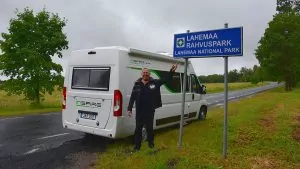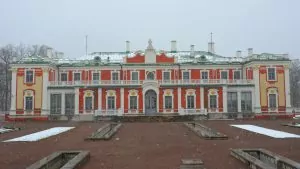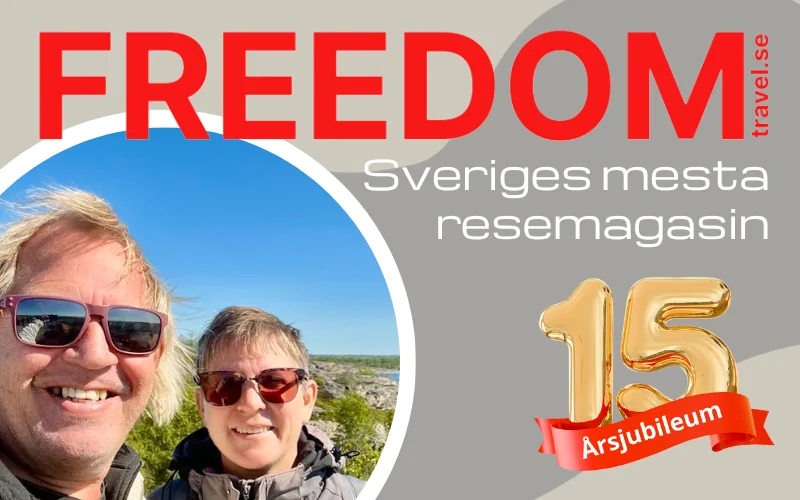Travel destinations in Estonia! Do you like medieval buildings, shopping, good restaurants, or perhaps luxurious spa hotels? Here are our top travel tips for Estonia!
Table of contents
Why travel to Estonia?
The whole of Estonia is a goldmine for nature and history lovers. You can visit the beautiful capital Tallinn, but also charming and interesting cities like Tartu, Pärnu and Haapsalu. Here you can eat in exciting restaurants, try beer from local microbreweries or enjoy a spa at reasonable prices.
Nature offers beautiful national parks, rushing waterfalls and beautiful islands. Visit, for example, Dagö, Ösel and Kynö, with Europe's last matriarchy. Here you will find plenty of tips and inspiration for your trip to Tallinn.
Travel destinations in Estonia - inspirational reading
Things to do in Estonia - 30 sights and experiences
What to see and do in Estonia? We offer 30 tips for a country...
Facts about Estonia - 30 things you (might) not know
Here are the facts about Estonia - 30 things you (maybe) didn't know about the country. Estonia is...
Cruise Stockholm - Tallinn with Victoria I
We have been on a cruise Stockholm - Tallinn with Victoria I from Tallink Silja Line. So...
Proto discovery workshop - experience centre in Tallinn
The Proto Discovery Workshop is an experience centre in Tallinn where you can discover and experience early technological developments,...
Tourest 2020 travel fair in Tallinn - travel destinations and delicacies
We have visited the Tourest 2020 travel fair in Tallinn, Estonia. Really fun and inspiring! The fair offers both ...
Ferry to Estonia - Tallink silja vs DFDS
Ferry to Estonia, which one to choose? On our last trip to Estonia, we tried two different ferry...
Travelling by motorhome in Estonia - all you need to know
What is it like travelling with a motorhome in Estonia? We have just returned home after barely...
Keila waterfall in Estonia - and a romantic park
In cooperation with the Estonian Tourist Board Keila Waterfall in Estonia is the country's third largest waterfall and is located...
Rummu quarry in Estonia - prison turned bathing paradise
In cooperation with the Estonian Tourist Board Rummu quarry in Estonia is a very different sun and bathing paradise,...
Haapsalu, Estonia - noise village charm on the coast
In collaboration with the Estonian Tourist Board Haapsalu in Estonia is a beautiful wooden town on the Estonian coast....
Dagö in Estonia - among lighthouses and Swedish history
In cooperation with the Estonian Tourist Board Dagö in Estonia is a green and scenic island, where...
Saaremaa in Estonia - the island of windmills
Saaremaa in Estonia is an island in the Baltic Sea the size of Gotland, known to all...
Kynö in Estonia - the island where women are in charge
In cooperation with the Estonian Tourist Board Kynö in Estonia is a small and very special island. It...
Pärnu in Estonia - beaches, spas and villas
In cooperation with the Estonian Tourist Board Pärnu in Estonia is known for its beaches, spas and...
The highest mountain in the Baltics - Suur Munamägi in Estonia
In cooperation with the Estonian Tourist Board We have "climbed" the highest mountain in the Baltics - Suur Munamägi in Estonia....
10 things to do in Tartu, Estonia
What to do in Tartu, Estonia? We spent three days in this...
Rally Estonia in Tartu - a great festival of people
In cooperation with the Estonian Tourist Board Rally Estonia in Tartu is a great folk festival that attracts...
Lake Peipus in Estonia - village festivals, onions and old-timers
Lake Peipus in Estonia is located in the eastern part of the country and is known for its...
Narva in Estonia - on the border with Russia
In cooperation with the Estonian Tourist Board Narva in Estonia is the EU's outpost against Russia, with the border crossing...
The cliffs of Ontika in Estonia - and Oru Park in Toila
In collaboration with the Estonian Tourist Board The cliffs of Ontika in Estonia are dramatically steep rock faces that plunge into the...
Rakvere fortress in Estonia - history and spectacle
In cooperation with the Estonian Tourist Board Rakvere Fortress is located on a hill in the town of Rakvere in the north of...
Lahemaa National Park in Estonia - nature and mansions
In cooperation with the Estonian Tourist Board Lahemaa National Park in Estonia is a large natural area that offers...
Motorhome holiday in Estonia - starting in Tallinn
We're finally off on a motorhome trip in Estonia, exploring the country for three weeks! We...
What to do in Tallinn - 30 sights and experiences
Looking for tips on things to see and do in Tallinn? We've visited Estonia...
Ferry to Tallinn - what not to miss
If you follow our blog, you know that we travelled by ferry to Tallinn during the Easter holidays. We...
Exploring the port of Tallinn, Estonia
One of the best things about travelling is discovery. Going on unplanned...
2 good hotels in Tallinn, Estonia - luxury or colour?
We have now tried two different good hotels in Tallinn, Estonia. The first night we stayed ...
Guided tour of Tallinn - the Kalamaja neighbourhood
Today you can join a guided tour in Tallinn, Estonia! We love guided tours. When...
An excursion to Kadriorg Palace in Tallinn, Estonia
It's all over the place here! A few days ago we were in Malta and now we are in...


More destinations in Estonia - bucket list

Viljandi
Viljandi has a history dating back to 1154 and later a city that was part of the Hanseatic League and Germany. The city and the then large fortress were an important part of a trade route to Russia. Discover the Church of St John (Jaani kirik ), St Paul's Church (Paulus Church ) and the castle ruins from Viljandi.

Runö (Ruhnu)
Runö in south-west Estonia is located in the centre of the Gulf of Riga and on the map it almost looks like it is in Latvia. The island is very flat and the highest point is only about 30 metres above sea level, and on that hill stands the Runö lighthouse. The lighthouse was made in Le Havre, France, and placed on Runö in 1877.
There are two churches on the island and the older wooden church dates from 1644. There are also two shops, two restaurants and a school. Swedes have lived here for several hundred years but had to leave in 1944 when the communists in the former Soviet Union took over.
Getting here: In low season, you'll travel every other day from Roomassare on the island of Saaremaa and Port 2 in Pärnu. At Christmas and August, boat transport from the harbour of Munalaid is extended. Cars are not allowed and info can be found here http://runöborna.se/runo-idag/.

Cassaria
The terrain on Kassari is very flat. The highest point on the island is 15 metres above sea level. Around 300 people live on the island in the four villages of Kassari, Taguküla, Orjaku and Esiküla.
The island of Kassari in western Estonia is connected by road to Dagö.. The island is home to the summer residence of writers Aino and Oskar Kallas and a limestone chapel with unique architecture and a reed roof. Of the seventeen windmills that have existed on the island, one remains - Ristete stump mill. The long headland of Sääretirp is a tourist favourite.

Ormsö (Vormsi)
Research has shown that around 1206 over 200 farmers had been shipped from Öland to form the basis of a new community. There have been Swedish speakers on Ormsö for 800 years and there is old Swedish history here.
Sviby ferry berth on Vormsi island The ferry departs from Sviby which operates between Vormsi and Rus on the Estonian mainland. Tickets can only be purchased at the kiosk on the land side and not on the island. You can take a car if you want or park for free and take a bike for a day instead. Info on the ferry at http://www.veeteed.com/

Great Rye (Suur-Pakri)
Stora Rågö has also had an exclusively Swedish-speaking population, and is strangely smaller than Lilla Rågö. The Rågö Islands are located in north-west Estonia.
It was sold by Abbot Nicolaus in Padi Monastery in Estonia, which was in dire need of money. The islands had no inhabitants during the war, but since 2000 there are some inhabitants again.
Getting here: Only by fast boat for you and your food. Info can be found for booking http://www.pakrisaared.ee/ and you go from Koris harbour to both Rye Islands. Other info can be found here http://home.aland.net/bosse/pakri.htm.

Lilla Rågö (Väike-Pakri)
The Rye Islands where the small island has been called Österö since 1345. Estonian Swedes lived on the island until the Second World War, and Swedish has been spoken here for 6 centuries.
There used to be two villages on the island, the city (Suurküla) and Lillbyn (VäikekülaAt the beginning of the 20th century there were 354 inhabitants on the island. The islands are located in the western strait off Paldiski.
Getting here: The same as for Stora Rågö.

Närgö (Naissaar)
Närgö is located in the Gulf of Finland north-west of Tallinn. The 46 metre high lighthouse stands on the northern part of the island. Swedes have also lived here for generations and on the surrounding islands (Karlsöarna).
In the middle of the 19th century around 150 people lived here, and in the early 1900s around 400 Estonian Swedes. All had to leave during the Second World War. Here you will find words such as Lillängen, Söderbyn, Bakbyn, Lillbyn and Ragnhillsgrundet, which has probably been used by several boats.
Getting here: Travel with Sunlines. One hour by cruise ship, around the island in a military truck. See Soviet caches, St Michael's Swedish Church and the cemetery.
Info and facts about Estonia
- Capital city: Tallinn
- Language: Estonian
- Residents: 1.3 million (2020)
- Currency: Euro
- National anthem: Mu isamaa, mu õnn ja rõõm
Good to know about Estonia
- Price mode: Cheap (cheaper than Sweden)
- Time difference: One hour
- Emergency number: 112
- El: Like Sweden
- Water: Drinkable
Accommodation in Estonia
- Hotel: There are plenty of hotels in every major city, so you can pick and choose for your trip to Estonia. For example, you can look on Booking.com.
- Camping: If you prefer camping, you can read more on our page about campsites and pitches in Estonia.
Travelling to Estonia
- Flight: You can fly directly from Stockholm to Tallinn with SAS or Ryanair.
- Ferry: You can travel with Tallink Silja from Stockholm to Tallinn. Another option is to travel with DFDS Seaways from Kapellskär to Paldiski.



































